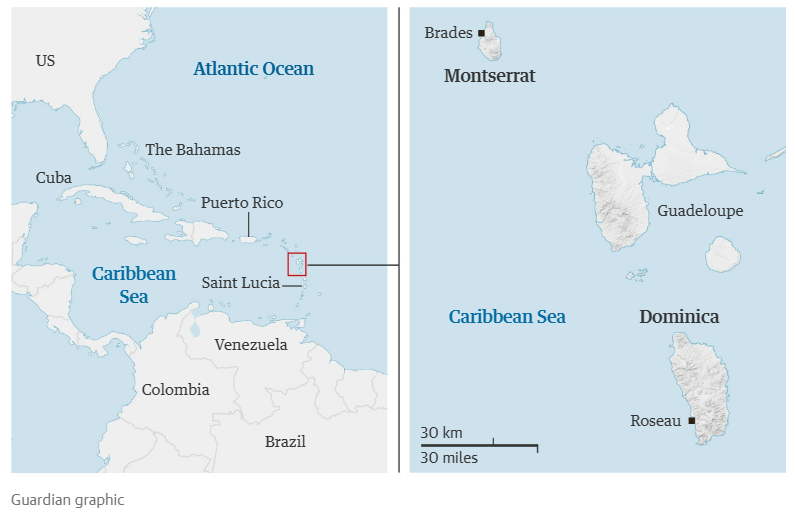Ecological calamity on the Caribbean island demonstrates how quickly wildlife can be destroyed, scientists say
They were once so numerous they were cooked as the national dish of Dominica. Every year, thousands of mountain chicken frogs, roasted with garlic and pepper, were eaten by islanders and tourists.
Two decades later, the animal – one of the world’s largest species of frog – has in effect disappeared from the Caribbean island. A series of ecological disasters has reduced its former healthy, stable population of hundreds of thousands of animals to a total of 21 frogs, according to scientists’ most recent survey.
The startling rapidity of Leptodactylus fallax’s decline has stunned biologists who believe it is one of the fastest eradications of a wild animal ever recorded, an ecological calamity that demonstrates how quickly wildlife can be damaged and destroyed.
“This is an amazing animal,” said Andrew Cunningham, head of wildlife epidemiology for the Zoological Society London (ZSL). “It can grow to around 20cm in length and weigh more than a kilo. Both males and females play important roles in raising their young and it was one of Dominica’s top predators that ate insects, small mammals, snakes – and other frogs.”

The island used to buzz with the sound of the call of the male mountain chicken frog, added Cunningham. “Today there is only silence. This is a species facing imminent extinction in the wild, yet it was in a healthy state only a couples of decades ago. Its fate sends us a very clear warning about the dangers facing wildlife on Earth today.”
The initial cause of the mountain chicken frog’s misfortunes was a chytrid fungus that first emerged in the last century and which infects amphibians’ skin through which many of them drink and breathe. Frogs become lethargic and die within a month.
The fungus has been blamed for significant amphibian declines in many parts of the world but nowhere has its impact been so rapid and all-consuming as it has been on the island of Dominica. Within 18 months of its first appearance in 2002, it had eliminated 80% of the island’s population of mountain chicken frogs.
“That is an astonishing decline,” said Cunningham. “And its numbers continued to drop until it was undetectable in the wild on Dominica.”
Worse was to follow. The mountain chicken frog was at that time found on only one other place on Earth: the nearby island of Montserrat. Scientists urged authorities there to introduce strict quarantine measures to halt the disease from spreading across the island.
“These warnings failed although, in one sense, we were prepared for the worst given what had happened in Dominica,” said Andrés Valenzuela, a wildlife health expert at ZSL’s Institute of Zoology. “We were able to collect some of the island’s mountain chicken frogs before the disease began to spread to them in 2009 and these animals are now housed in bio-secure enclosures at several zoos in Europe, including London’s.”
One other piece of encouraging news followed in Dominica with reports that a handful of surviving frogs had been uncovered and these animals appeared to be naturally resistant to the chytrid fungus. “Things looked a bit better – until Hurricane Maria hit the island in 2017,” said Jeanelle Brisbane, wildlife ecologist with the Forestry, Wildlife and Parks Division in Dominica and founder of WildDominique.

“It was the strongest hurricane ever to have hit the island in our recorded history and the devastation shattered the already fragile population of frogs, reducing numbers by more than 90% – back down to double digits.”
This has left the once numerous mountain chicken frog in a dismal situation. There are zoo collections of animals from Montserrat in Europe. Crucially, these animals are not resistant to chytrid fungus and their usefulness for reintroduction is therefore limited.
By contrast, those members of Leptodactylus fallax that are clinging on in Dominica are resistant but exist in only two small populations on land that offers no official protection to the species.
In addition, climate changes are affecting both islands – drying out weather systems – and this is also hindering efforts to save the species. Its prospects look grim, though Brisbane remained optimistic.
“We’ve managed to keep the mountain chicken frog alive and able to survive the fungal disease for over 20 years now, thanks to the collaboration that has gone in to saving this species. We should not forget that. If we can keep that up for just a bit longer, with the right resources, it is possible to turn their fate around. Certainly we are not giving up hope.”
Cunningham agreed. “We still have a couple of years to try to get something done before the mountain chicken frog becomes extinct in the wild. It’s a tight situation.”
